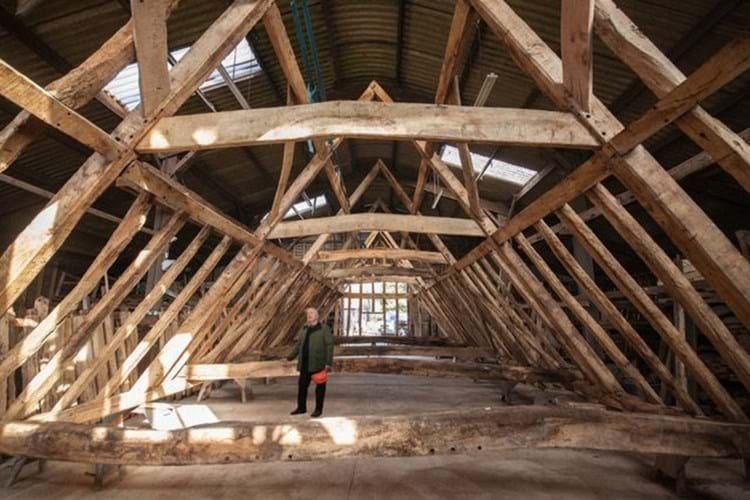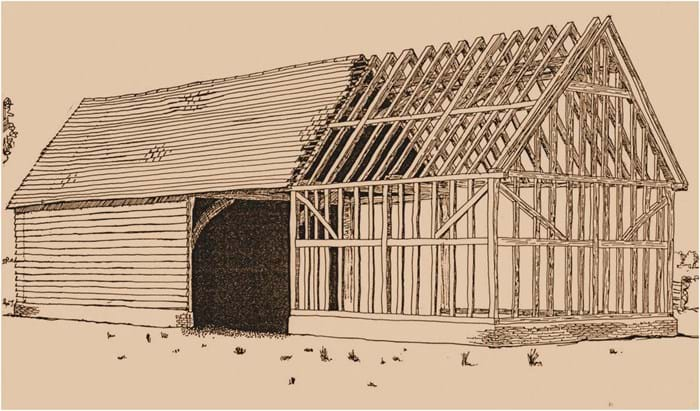
Not many of them will be around 51ft long and 20ft wide (15.5 x 6m), however.
Oh, and about 26ft (8m) tall. And weighing in the region of 20 tons.
This is a barn find in the literal sense: Summers Place Auctions’ spring sale includes a magnificent barn built within the original grounds of the Order of the Knights of St John Hospitallers in Suffolk where they first based themselves in 1154.
As well as putting the structure back together, though, the buyer will also need a suitable plot of land upon which it can be rebuilt.
Timbers dating back to Elizabeth I era
The original part of the thatched roofed, wattle and daub clad oak framing of the building’s core was constructed between 1760-80. However, some of the oak timbers were from an earlier building, which could well have been dating back to the time when the farm was owned by Sir Thomas Gresham, who was instrumental in setting up the Royal Exchange under Queen Elizabeth I.
It comes with its detailed drawings, which is crucial as no two timbers are the same. If a barn has not been taken down properly with every timber marked, it is virtually impossible to assemble it again.
The vendor purchased the barn from the company he worked for in 2001 with a view to have this as a retirement project. The company, specialising in selling English barns all over the world, had bought it from the parents of the present owner of St John’s Manor, Battisford, in 1985, John and Pat Knock, who wrote a booklet on the history of the manor and its barn (see stjohnsmanorbarn.com for more background).
This barn is estimated at £70,000-100,000 at Summers Place, of Billingshurst, West Sussex, as part of the sealed bids section part of the May auction - bids need to be in by May 19.

A view of the St John's Barn structure - the dismantled building is being sold by Summers Place Auctions by May 19 with an estimate of £70,000-100,000.
Early recycling
It was a common practice during the early English framing periods (15th-18th centuries) to incorporate timbers from earlier buildings and some of the timbers from this barn show carpenters' earlier workings and thus it is thought highly likely that at least a small percentage of those timbers date back to the Tudor period.
From a 2013 Oxford Dendrochronology Laboratory report it could be deduced that the wall timbers were converted from trees which showed signs of intense management practice. This is consistent with evidence that Battisford and Ringshall in the 14th-18th centuries comprised vast oak woodlands which would have been actively managed.
A 2015 Oxford University Radiocarbon analysis showed a 96% certainty that the building was reconstructed between 1760-80.
A bit more history…
The monastic order of the Knights Hospitaller was founded after the First Crusade by the Blessed Gerard and confirmed by a Papal bull (or charter) from Pope Paschal II in 1113.
They established the first significant Hospitaller infirmary near the Church of the Holy Sepulchre in Jerusalem and provided pilgrims with armed escorts for their journey, but before long grew into a substantial force and they quickly became the most powerful Christian group in the area.
With its increasing recognition and acceptance in England and Normandy, the Preceptory at Battisford was established, probably on a nobleman’s land in 1154, according to the records at the Order of St John's Hospitallers headquarters in St John's Gate, Clerkenwell, London. In 1310, it was then chosen by King Edward II (1284-1327) as a Commandery, a substantial fortification.
The barn was built in the original grounds where the Preceptory was established in 1154. In the 1530s, during the Reformation under Henry VIII, the Commandery was seized and confiscated. The 16th and last Commander at Battisford, prior to the Reformation, was one William Tyrell.
Gresham ownership
Not much is known about what happened for the next few years. However, records show that in 1544 the estate was sold to Richard Gresham (1485-1549), an important noble at the Court of King Henry VIII.
Richard’s son Thomas inherited the estate in 1549 and lived through the years of the death of Henry VIII, the brief years of reign of Edward VI and Queen Mary I, before becoming courtier to Elizabeth I who was crowned in 1558.
After re-introducing his family name at Royal Court, Thomas was shortly thereafter appointed Royal Agent at Antwerp, Belgium, at a time when it was necessary for the English Crown to raise money abroad.
Seeing the vast wealth of both Venice and Antwerp originating from the financial wizardry of those cities' merchants, Thomas then put into practice an idea his father had had, namely that London should have its own Bourse. He acquired land along Lombard Street and at Cornhill, where he built London’s new Bourse.
Thomas was given a knighthood for his efforts, and like his father also became Lord Mayor of London. At his death not many years later, he was said to have been the wealthiest noble in England.
The Royal Exchange
Battisford oak was used to build the new Bourse. During the reign of Queen Elizabeth I (1558-1603), Battisford was well known for the quality and abundance of its oak trees and so it was an easy choice in 1566 for Thomas to have his proposed Bourse framed in oak, from his own woodlands.
Records show that the huge oak frames of this mighty building were framed at Battisford Tye (or Common) and then dismantled, taken by barge around the coast and up the Thames, to the Port of London, and thence transported to Cornhill to form the new Bourse. It was completed in 1568 of faux stone and brick cladding over the mighty oak frames.
In 1570, Thomas Gresham accompanied Elizabeth I around the huge building, who proclaimed it be henceforth known as The Royal Exchange.
Sadly his amazing building was destroyed in the Great Fire of London (1666).





